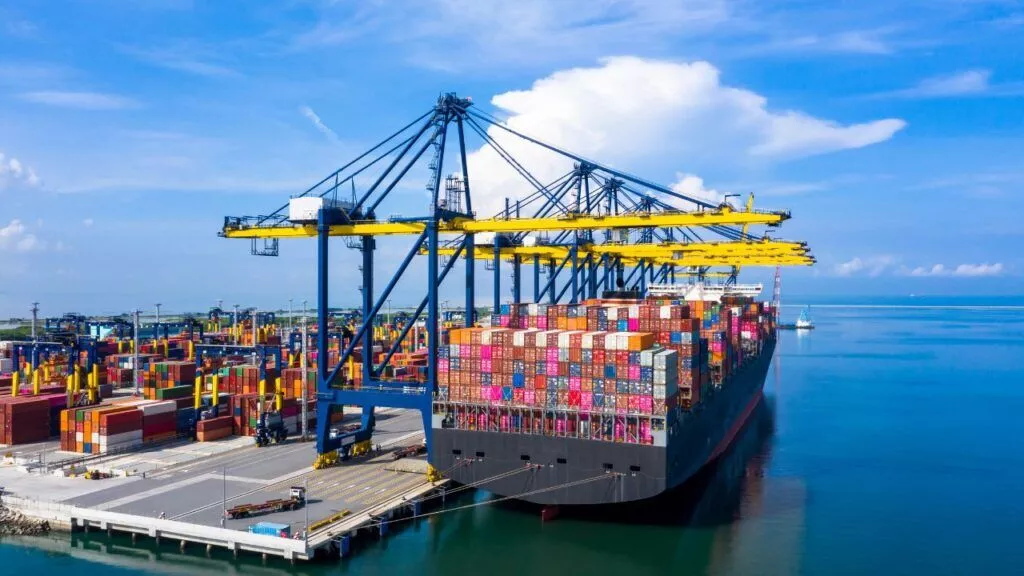- By TOP CHINA FREIGHT
- October 9, 2025
- Sea Freight, Shipping
Table of Contents
Electronics sea freight China to Europe is one of the most cost-effective and reliable ways to move large volumes of goods. However, shipping electronics internationally requires careful planning, compliance with regulations, and a deep understanding of global logistics. This comprehensive guide covers everything you need — from costs and transit times to container types, customs clearance, and practical tips for smooth delivery.

What Is Electronics Sea Freight from China to Europe?
Electronics sea freight refers to transporting electronic devices, components, or accessories from Chinese ports to European destinations via ocean vessels. It is widely used by manufacturers, wholesalers, and e-commerce sellers who prioritize cost efficiency over speed.
Unlike air freight, which delivers within days, sea freight usually takes several weeks. However, the advantage lies in its ability to handle large, heavy shipments at a fraction of the cost — ideal for bulk electronics such as televisions, computers, or smart home devices.
| Shipping Method | Transit Time | Cost (per kg) | Best For | Reliability |
|---|---|---|---|---|
| Air Freight | 5–10 days | $5–10 | Urgent, high-value items | Very High |
| Rail Freight | 15–25 days | $2–4 | Moderate loads | High |
| Sea Freight | 30–40 days | $0.5–1.5 | Large, bulk cargo | High |
Why Choose Sea Freight for Electronics Shipping?
Sea transport offers the cheapest per-unit cost for heavy or bulky goods.
Containers can hold large quantities of electronics, reducing the per-unit shipping expense.
Containers provide excellent protection against damage and theft during transit.
Compared to air freight, ocean shipping produces significantly fewer carbon emissions.
Which Ports Are Commonly Used for Electronics Sea Freight?
Choosing the right ports can greatly affect cost and transit time. Below are the most frequently used ports for electronics sea freight China to Europe.
| Origin Port (China) | Destination Port (Europe) | Average Transit Time | Common Routes |
|---|---|---|---|
| Shanghai | Rotterdam (Netherlands) | 32–38 days | Direct |
| Shenzhen | Hamburg (Germany) | 30–35 days | South China Route |
| Ningbo | Antwerp (Belgium) | 35–40 days | East China Route |
| Qingdao | Marseille (France) | 38–42 days | Northern China Route |
| Xiamen | Valencia (Spain) | 36–41 days | Southeast China Route |
Each port has specific advantages. For example, Shanghai handles high-volume electronics exports, while Shenzhen is ideal for technology goods from the Guangdong manufacturing cluster.
How Much Does Electronics Sea Freight from China to Europe Cost?

Shipping costs vary based on several factors — including container size, shipment volume, destination, and seasonality. Below is a general cost overview:
Note:
Prices fluctuate depending on oil prices, exchange rates, and peak seasons (especially before Christmas or Chinese New Year). Therefore, always request updated quotes from your China freight forwarder.
What Documents Are Needed for Electronics Sea Freight?

Proper documentation ensures smooth customs clearance. Missing paperwork can delay your shipment or result in penalties.
| Document | Description | Required By |
|---|---|---|
| Bill of Lading (B/L) | Proof of cargo ownership | Carrier & Customs |
| Commercial Invoice | Details the transaction value | Import Customs |
| Packing List | Lists quantity and packaging info | Customs |
| Certificate of Origin | Confirms manufacturing country | Importer’s Country |
| CE Certification | Required for electronics entering EU | European Customs |
| Import License | Depending on product category | Buyer or Agent |
Additionally, ensuring compliance with EU safety standards and RoHS directives is crucial for electronics shipments.
How Long Does It Take to Ship Electronics from China to Europe?
Transit time depends on factors such as route, port congestion, and shipping service type. Typically, electronics sea freight China to Europe takes 30–45 days door to door.
| Shipping Route | Estimated Transit Time | Service Type |
|---|---|---|
| Shanghai → Rotterdam | 32–38 days | Direct |
| Shenzhen → Hamburg | 30–35 days | Direct |
| Ningbo → Antwerp | 35–40 days | Transshipment |
| Qingdao → Marseille | 38–42 days | Transshipment |
To reduce delays, coordinate with your freight forwarder to book vessels in advance, especially during high-demand months.
How to Pack and Ship Electronics Safely by Sea
Electronics are sensitive to moisture, shock, and temperature changes. Proper packaging is essential to prevent damage.
Key Packing Tips:
- Use anti-static and shock-absorbing materials.
- Ensure double-layer cartons with reinforced corners.
- Use desiccant packets and moisture-proof film.
- Clearly label fragile items and keep cargo upright.
- For high-value goods, consider insurance coverage for added protection.
Additional Tip:
Always conduct a pre-shipment inspection to ensure compliance with both Chinese export and EU import regulations.
What Are the Main Shipping Options: FCL vs. LCL?

Depending on your shipment size, you can choose between Full Container Load (FCL) or Less than Container Load (LCL).
| Option | Description | Pros | Cons |
|---|---|---|---|
| FCL (Full Container Load) | Exclusive use of one container | Faster, safer, cheaper per unit | Requires larger volume |
| LCL (Less than Container Load) | Shared container with other cargo | Lower cost for small loads | Longer handling time |
For fragile electronics, FCL shipping is usually preferred since it minimizes handling and potential damage.
Case Study: Shipping Electronics from Shenzhen to Hamburg

A Shenzhen-based electronics exporter shipped 40ft container of smart home devices to Hamburg, Germany.
- Cargo Volume: 28 CBM (18 tons)
- Freight Type: FCL
- Total Cost: $2,400 (including origin charges)
- Transit Time: 34 days
- Customs: CE-certified and duty cleared within 48 hours
The result: Efficient delivery under 35 days with no cargo damage. The exporter saved approximately 60% compared to air freight, ensuring stable supply for their European retailers.
How to Manage Customs Clearance Efficiently
Match HS codes with product specifications.
CE, RoHS, and EMC compliance are mandatory for most electronics.
They coordinate with customs brokers to avoid inspection delays.
Each EU country has different tax rates, usually ranging from 17%–23%.
How to Reduce Shipping Costs for Electronics Sea Freight
Reducing logistics costs helps improve profit margins. Here are practical strategies:
- Consolidate shipments to reduce per-unit cost.
- Book early to avoid peak season surcharges.
- Choose direct routes to minimize transshipment fees.
- Negotiate long-term contracts with carriers or freight forwarders.
- Optimize packaging size to maximize container utilization.
Moreover, working with a trusted China freight forwarder ensures you get access to bulk rate discounts and priority vessel space.
Conclusion
Shipping electronics via sea freight from China to Europe is the most practical choice for large-scale importers. It offers unbeatable cost efficiency, reliability, and scalability for your supply chain. Although transit time is longer, the savings and safety make it the preferred solution for most electronic products. Partnering with an experienced electronics sea freight China to Europe provider ensures smooth customs clearance, timely delivery, and complete supply chain visibility.
Need a Shipping Quote?
If you want expert guidance and peace of mind, our team is ready to assist.
TJ China Freight offers tailored solutions to help businesses of all sizes ship more reliably from China.

FAQ
Q1: How long does sea shipping take for electronics?
Transit usually takes 30–45 days. Direct routes like Shenzhen to Hamburg are faster, while transshipment routes may add several days.
Q2: What certifications are required for EU electronics imports?
CE marking, RoHS, and EMC certifications are mandatory for most electronics entering Europe to meet safety and environmental standards.
Q3: Can I ship lithium batteries by sea?
Yes, but they must comply with IMDG regulations. Always declare batteries properly to avoid delays or penalties.
Q4: Is insurance required for sea freight shipments?
Insurance is optional but recommended for electronics. It protects against damage, theft, or loss during transit.
Q5: How are customs duties calculated in Europe?
Duties depend on product type and HS code, usually 2–5%, plus VAT. Your customs broker can provide precise estimates.



